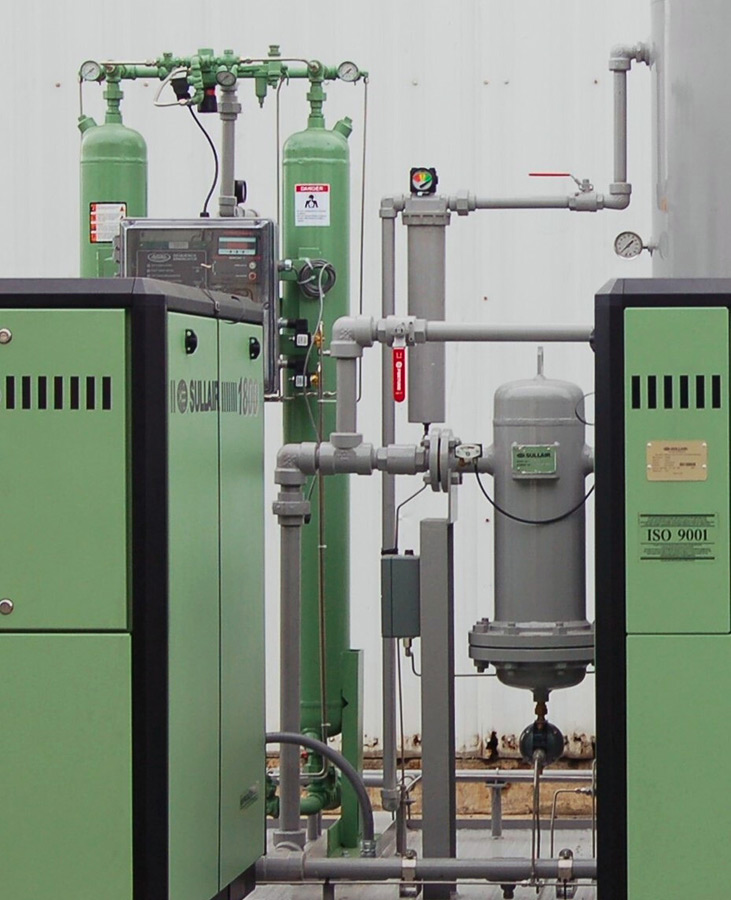
You’ve spent a lot of time sourcing and properly installing the right air compressor for your facility. You have your maintenance schedule set and plan to perform regular oil sampling and follow your OEM’s recommended service intervals. You should be all set to sit back and enjoy reliable air power, right? Not quite. There are other often overlooked components in an optimized compressed air system that are critical to helping you get the most out of your compressed air system: pipes, valves, and fittings. If one part of the compressor system’s supporting components isn’t installed, operating, or designed correctly, you may be at risk for, at best, lowered efficiency, and at worst, a shut down.
 Pipes are the conduits that carry the compressed air to your process once it leaves the compressor. All compressors come with a discharge pipe connection sized by the manufacturer to have the proper and minimal pressure drop for the best compressor operation. Added to this connection is a manual (or automatic) shut-off valve. This disconnects the compressor from the compressed air system in times of maintenance.
Pipes are the conduits that carry the compressed air to your process once it leaves the compressor. All compressors come with a discharge pipe connection sized by the manufacturer to have the proper and minimal pressure drop for the best compressor operation. Added to this connection is a manual (or automatic) shut-off valve. This disconnects the compressor from the compressed air system in times of maintenance.
The system piping to the plant after the shut-off valve, needs to be at least the size of the discharge connection at the compressor. The size of the pipe at the discharge of the compressor should never be reduced. Increasing the size of the piping, however, is usually beneficial to a compressed air system from a control reliability standpoint. The piping should also have the least number of 90-degree elbows as possible. In a good installation, sweeping piping radius bends are the best solution. These will help reduce the pressure drop every 90-degree elbow affords. As the piping connects to the main header, it is always good practice to connect the air at the top of the main header. If this is not done, then the pipe coming from the compressor can act as a “drip leg” and force condensation into the compressor.
In terms of materials for the piping, there are several options, and each comes with their own advantages and disadvantages. Your compressed air specialist can help determine which type works for your application. Typically, aluminum piping is used as it is lightweight, non-corrosive, and easy to work with. Galvanized piping is sometimes used but is heavy and challenging to fit. Copper piping is also used but can be expensive. Older systems often have iron pipes which should be replaced; over time, the residual water from the compressed air system can react with the iron pipes causing a buildup of corrosion and therefore reducing air flow.
In addition to the shut-off valve mentioned above, for proper maintenance a 3-valve bypass should be installed around each added and maintained piece of equipment, such as filters and dryers in the compressed air system. At some point in time, the in-line filters will need to be changed, and maintenance will need to be performed. Another good practice to follow is when the piping contractor is onsite, have the installer add a pipe with a ball valve before the filters and dryer somewhere near the compressor room or penetrating an outside wall. At times, the compressor will need maintenance and to be shut down. This additional connection will allow the customer to easily hook up a rental compressor so maintenance can be completed without interrupting the air flow, particularly useful at preventing unplanned downtime due to emergency maintenance, etc.
Quality air compressors are designed with safety in mind from pressure ratings on air storage tanks to emergency stop buttons. And for the most part, you normally do not have to worry about a safety issue arising. In fact, to prevent an issue should it arrive, air compressors come equipped with an air pressure relief valve (PRV), sometimes called a safety relief valve, that is designed to work if other safety features fail (again, this is very unlikely). The pressure relief valve protects the compressor component it is attached to from being exposed to a pressure above its rated maximum operating pressure. This rating, called the maximum working pressure (MWP), is the pressure the vessel has been certified to continuously operate at safely. When a compressor is running at or below its maximum working pressure—in other words, when it’s running “normally”—the relief valve doesn’t do anything. However, when the air pressure inside a compressor exceeds its MWP, the pressure relief valve will activate to “blow off” the excessive pressure within the compressor. Without a relief valve, the storage tank could rupture from the excessive pressure, damaging the compressor, other property near it, and possibly even causing injuries (or worse) to anyone standing nearby.
Under normal circumstances, the air pressure in a compressor is controlled by a pressure switch in an electro/mechanical control system or, in the case of an electronic controller, a pressure transducer and controller settings. When the cut-out set pressure for the pressure switch is reached, the compressor will stop compressing air until the cut-in set pressure is reached at which time it will start compressing air again. If the pressure switch fails, the compressor would not be able to start compressing air again, or potentially worse, not be able to stop. Most compressors also have a high-pressure safety switch that should stop the compressor if the pressure exceeds the unload set point.
A pressure relief valve is a straightforward safety backup to the pressure switch and high-pressure switch, or the controller set points, should any of these components fail with the compressor running. The safety relief valve is set above the high-pressure safety switch and generally at or below the vessel’s maximum operating pressure. Inside the valve is a spring, and the pressure created by the spring’s tension keeps the valve closed under normal operating conditions. However, as the air pressure increases in pressure vessels (like the storage tank), it may eventually exceed the rated pressure of the relief valve, causing the relief valve to open and the excess pressure to be “blown off” to the atmosphere.
What happens when the pressure relief valve fails depends on whether it fails with the valve open, or the valve closed.
If the pressure relief valve fails to open, air will continually vent to the atmosphere, preventing the air stream from becoming fully pressurized. The compressor should be shut down and the relief valve replaced before the compressor is restarted. The open relief valve will likely cause a loss of production and possible danger to personnel as a result of the flow of high-pressure air potentially with flying debris. The open valve can also produce an unsafe sound level.
A pressure relief valve failing closed presents a potentially more dangerous situation. As noted earlier, the relief valve exists to allow excessive pressure to be “blown off” so that the air pressure inside the compressor’s pressure vessels don’t exceed their rated specifications. If the valve fails closed, this pressure venting can’t happen. Unless compressed air demand matches the compressed air supply, the pressure inside the compressor will continue to build. Eventually, the pressure increase would cause the storage tank to rupture, damaging the compressor and possibly causing additional damage and injury to property and people nearby.
If the pressure relief valve is opening and whether that is because of excessive pressure in the compressor or because the valve is failing, you should have your local air compressor servicer inspect your compressor before running it again for two reasons:
Running the compressor after the relief valve has opened can put both your property at risk of damage and people at risk of injury (or worse).
If your pipes are leaky, your system is losing air — and efficiency. Checking for leaks in a compressed air system should be an on-going activity. One approach to managing leaks is to segment the plant into 10 – 12 relatively equal areas, based on the distribution of production equipment using the compressed air power. Assigning one segment per month for a leak audit allows the entire plant to be audited each year.
And the leak doesn’t have to be large to start to drag down your efficiency levels. Even small leaks can become costly fast. By some reports up to a third of compressed air is lost due to leaks and the corresponding elevated system pressure to compensate for that loss. If an industrial user has 200 HP online (approximately 1,000 acfm capacity), the leaks and inappropriate uses of compressed air consume a significant quantity of electrical power, needlessly add to the cost of electrical power for the plant and contribute to carbon emissions unnecessarily.
| Leaks and Artificial Demand | kWh/year | $/year | US (short) tons CO2/year |
|---|---|---|---|
| 200 acfm | 352,000 | $27,139/year | 392 |
| 300 acfm | 528,000 | $40,709/year | 589 |
| 400 acfm | 704,000 | $54,278/year | 785 |
Piping leaks usually happen over time due to vibrations, damage, and more. To root out the sources of leaks, most OEMs recommend an air audit. Almost always these audits find inappropriate uses and loss of compressed air, so the exercise is absolutely worth the effort.
Since many air leaks are small, most air auditors use an ultrasonic leak detector. The frequency range of most leaks is higher than what can be heard by the human ear enabling the detector to find all those small leaks that may otherwise go unfixed.
A best practice is to document each leak when it is identified. Many ultrasonic leak detectors include cameras so the leak can be photographed allowing the user to include a description such as the location in the plant. And, along with documenting the leak information, attaching a two-part tag to the leak makes locating the leak for repair easy for the maintenance team.
Logging the intensity of the leak is also a good practice to follow. The leak intensity can be used to estimate the power cost of the leak and allows the maintenance team to determine if a leak is worth fixing. For example, the packing gland and seat in a valve are found to be leaking, but the leak cannot be repaired without replacing the valve. The cost of the valve, plus the labor associated with the repair, could cause the repair to be more expensive to fix than to let continue to leak.
While your air compressor is the largest and most important part of your efficient compressed air system, the piping, valves, and fittings that carry the air from the compressor can have a huge impact on the cost to run your system and the safety of your operation. Utilizing the right parts and connectors and remembering to regularly check these often overlooked components can mean significate savings and a more optimized compressed air system — and there’s nothing boring about that.
Use the checkboxes to select the types of cookies you want to accept, then press the “Save Settings” button. View our Privacy Policy.